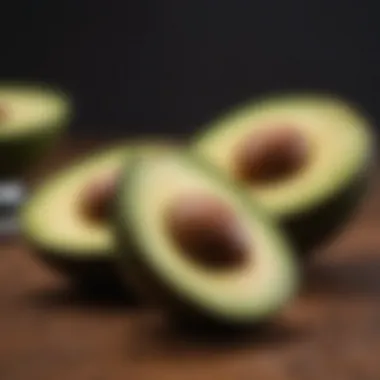Natural Foods to Effectively Lower Blood Pressure


Intro
High blood pressure is a significant health issue affecting a large portion of the global population. It may lead to severe complications, including heart disease, stroke, and kidney failures. Often called the silent killer, high blood pressure typically presents no symptoms until serious damage occurs. Therefore, understanding how to manage it, particularly through diet, can be transformative.
Understanding these elements can transform one's relationship with food and offer sustainable strategies for long-term health improvement.
Understanding Blood Pressure
Blood pressure is a critical health metric that indicates the force of blood against the walls of the arteries. Understanding blood pressure is pivotal for health management, especially in preventing cardiovascular diseases. This section delves into what blood pressure is, why managing it is essential, and factors leading to its elevation. Knowledge in these areas can empower individuals to make informed lifestyle choices, particularly regarding diet.
What Is Blood Pressure?
Blood pressure is measured in millimeters of mercury (mmHg) and is represented by two numbers: systolic and diastolic pressure. The systolic pressure occurs when the heart beats, pushing blood into the arteries, while diastolic pressure reflects the pressure in the arteries when the heart rests between beats. A typical reading is noted as systolic over diastolic, for example, 120/80 mmHg. Abnormal readings can indicate potential health issues.
Understanding these figures is fundamental because they inform us about the heart's efficiency and arterial health. Maintaining blood pressure within recommended ranges can help avert serious health complications.
The Importance of Blood Pressure Management
Managing blood pressure is crucial for maintaining overall health. Elevated blood pressure, or hypertension, increases the risk of heart disease, stroke, and kidney failure. By controlling blood pressure, individuals can significantly reduce these risks. Health management often calls for regular monitoring and lifestyle adjustments.
Benefits of Effective Management:
- Enhanced Longevity: Keeping blood pressure in check contributes to a longer, healthier life.
- Reduced Medical Costs: Lower likelihood of serious diseases can minimize healthcare expenses.
- Improved Quality of Life: Better cardiovascular health leads to increased energy and vitality.
"Good blood pressure management is key to preventing serious health problems and promoting a better quality of life."
Factors Contributing to High Blood Pressure
High blood pressure can stem from a variety of sources. Some factors are controllable, while others are not.
Common Contributors Include:
- Poor Diet: High salt intake and low potassium levels can elevate blood pressure.
- Obesity: Excess body weight puts additional strain on the heart.
- Lack of Physical Activity: Sedentary lifestyles may contribute to weight gain and hypertension.
- Stress: Chronic stress can lead to unhealthy habits that affect blood pressure.
- Genetics: Family history can play a role in one's susceptibility to hypertension.
- Age: Blood pressure tends to increase with age, necessitating more rigorous monitoring.
Recognizing these factors is essential for individuals aiming to lower their blood pressure. By addressing controllable elements through lifestyle changes, it is possible to make significant strides in blood pressure management.
The Role of Diet in Blood Pressure Control
Understanding how diet impacts blood pressure is crucial for effective management of this common health issue. Through dietary choices, individuals have the potential to significantly influence their cardiovascular health. The foods you consume can directly affect blood vessel function and overall heart health. It is not only about seeing short-term results but adopting dietary practices that support long-term wellness. This section will explore how your daily food choices can lower blood pressure and promote a healthier lifestyle.
How Diet Influences Blood Pressure
Diet plays a significant role in regulating blood pressure levels. Certain foods can either contribute to hypertension or assist in managing it. Sodium intake is particularly noted for its impact; high-salt diets can create excess pressure in blood vessels. In contrast, a well-balanced diet rich in fruits, vegetables, and whole grains proves effective in calming high blood pressure.
A diet low in sodium and rich in potassium, magnesium, and fiber helps normalize blood pressure.
Several studies show that individuals who consume a diet emphasizing natural foods tend to have lower blood pressure levels. This correlation emphasizes the need to review daily choices and make adjustments accordingly, prioritizing health over convenience.
The DASH Diet: An Overview
The Dietary Approaches to Stop Hypertension (DASH) diet is a proven method for reducing high blood pressure. It emphasizes the consumption of nutrient-rich foods while limiting those that are high in sodium, saturated fats, and added sugars. The DASH diet encourages foods that are high in potassium, magnesium, and calcium, as these nutrients promote heart health. Key components of the DASH diet include:
- Fruits and vegetables: These are rich sources of vitamins and minerals.
- Whole grains: Foods like brown rice and whole wheat bread provide essential fiber.
- Low-fat dairy: Offers calcium without excessive saturated fat.
- Lean meats, fish, and nuts: Provides important proteins and healthy fats without high calorie counts.


Following the DASH diet not only lowers blood pressure but may also lead to weight loss and a healthier lifestyle.
Key Nutrients for Blood Pressure Regulation
Understanding which nutrients can diminish blood pressure is essential for making informed dietary choices. Here are several key nutrients to consider:
- Potassium: This mineral helps balance sodium levels in the body, which is critical for managing blood pressure. Foods such as bananas, oranges, and potatoes are excellent sources of potassium.
- Magnesium: It plays a significant role in vascular health. Green leafy vegetables, nuts, and seeds are rich in magnesium.
- Calcium: Important for muscular function, including the muscles surrounding blood vessels. Low-fat dairy and fortified foods can provide adequate calcium.
- Omega-3 Fatty Acids: Found in fatty fish such as salmon and walnuts, these have anti-inflammatory properties and can promote better heart health.
- Fiber: High-fiber diets are associated with lower blood pressure levels. Foods like oats, beans, and whole grains are good sources of fiber.
Remember that achieving a balanced diet with these nutrients is vital for maximizing their benefits. Focusing on variety and moderation will help ensure you obtain all these essential nutrients.
Natural Foods Known to Lower Blood Pressure
Understanding the connection between diet and blood pressure is crucial. Natural foods, rich in vital nutrients, can play a significant role in managing blood pressure levels. Emphasizing specific food choices can empower individuals to cultivate healthier eating habits that directly impact cardiovascular health. This section provides a closer look at various natural foods recognized for their blood pressure-lowering effects. It further discusses the unique properties of these foods that make them beneficial in promoting overall heart health.
Leafy Greens
Types of Leafy Greens
Leafy greens such as spinach, kale, and Swiss chard are packed with nutrients that help manage blood pressure. These greens are high in potassium, which works to balance sodium levels in the body, thus reducing tension in blood vessels. Spinach is particularly notable for its high content of vitamins A, C, and K, while kale offers antioxidants that combat oxidative stress. The inclusion of these greens is straightforward and offers a wealth of health benefits that align with blood pressure management.
Nutritional Benefits
The nutritional profile of leafy greens is impressive. They are low in calories, yet they contain essential vitamins, minerals, and antioxidants. These compounds are known to improve vascular function and support overall heart health. For instance, vitamin K found in these greens can help protect arteries and maintain proper blood circulation. Their low-calorie content is beneficial for those aiming to maintain a healthy weight, further aiding in blood pressure control.
Incorporating Leafy Greens into Your Diet
Incorporating leafy greens into daily meals is simple. They can be added to smoothies, salads, or cooked in various dishes. For instance, a spinach salad topped with nuts and a light dressing provides an easy way to enjoy their benefits. Cooking leafy greens can enhance their flavor while retaining most nutrients, making them easy to integrate into any diet.
Berries
Varieties of Berries
Different types of berries, including blueberries, strawberries, and raspberries, offer significant health benefits. Blueberries are especially known for their high flavonoid content, which has been linked to improved heart health. Strawberries and raspberries provide a rich source of vitamin C and antioxidants that support overall well-being. The vibrant colors of berries serve as a reminder of their numerous health benefits.
Health Impacts on Blood Pressure
Berries have been shown to have beneficial effects on blood pressure. Regular consumption can help reduce systolic and diastolic blood pressure due to their positive effects on blood vessels. This phenomenon is attributed to the compounds present in berries that promote blood circulation and reduce inflammation.
Ways to Consume Berries
There are various ways to consume berries. They can be enjoyed fresh as a snack, added to yogurt, or included in smoothies. Freezing berries also preserves their nutrients, allowing for easy use in various recipes year-round. Their versatility makes them an appealing option for improving heart health.
Beets
Nutritional Composition of Beets
Beets are a source of essential nutrients, including fiber, vitamins A and C, and potassium. They contain nitrates, which have been linked to improved blood flow and reduced blood pressure. This nutrient composition makes beets a strong contender in the fight against hypertension.
Effects of Beets on Blood Pressure
The consumption of beets may lead to significant reductions in blood pressure levels. The nitrates present in beets convert to nitric oxide in the body, which relaxes and widens blood vessels. This process can enhance blood flow and lower overall blood pressure, providing a simple yet effective natural remedy.
Preparation Methods for Beets
Beets can be prepared in numerous ways. They can be roasted, boiled, or juiced, with each method highlighting their natural sweetness. A popular way to enjoy beets is in salad form, paired with feta cheese and nuts. This not only creates a vibrant dish but also integrates essential nutrients effectively.


Oats
Why Oats are Beneficial
Oats are a staple in many diets and are known for their heart-healthy properties. They are rich in beta-glucan, a type of soluble fiber that helps lower cholesterol levels and promote heart health. Including oats in breakfast routines can set a positive tone for the day.
Fiber Content and Blood Pressure
The fiber content in oats contributes significantly to their blood pressure-lowering effects. High fiber intake is associated with reduced blood pressure as it aids in maintaining healthy body weight and lowering cholesterol levels. Regular consumption of oats can create beneficial changes in one's cardiovascular health.
Recipe Ideas Using Oats
Incorporating oats into meals can be straightforward. They can be enjoyed as oatmeal, added to smoothies, or used as a base for healthy snacks like granola bars. Combining oats with fruits or nuts enhances their nutritional value while offering various textures and flavors.
Bananas
Potassium in Bananas
Bananas are a well-known source of potassium. This mineral is crucial for maintaining proper heart function and regulating blood pressure. A diet rich in potassium can help counteract the effects of sodium, thus supporting better cardiovascular health.
How Bananas Contribute to Lowering Blood Pressure
The potassium content in bananas aids in lowering blood pressure by facilitating the movement of sodium into and out of cells. This balance reduces blood pressure levels, making bananas an effective fruit for blood pressure management. Good news for those wanting to snack healthier!
Daily Serving Suggestions
Incorporating bananas into daily meals is easy. They can be eaten raw, added to cereal, or blended into smoothies. A daily banana can be a quick and nutritious choice, helping individuals meet their potassium needs easily.
Garlic
Active Compounds in Garlic
Garlic contains allicin, a compound known for its medicinal properties. This active compound has been shown to have positive effects on blood pressure regulation. The unique flavor and health benefits make garlic a potent ally in heart health.
Garlic's Mechanism in Blood Pressure Control
Garlic's mechanism for managing blood pressure involves promoting the dilation of blood vessels. This helps improve blood flow and reduces overall pressure within the arteries. The incorporation of garlic into one’s diet serves both flavor and health purposes simultaneously.
Using Garlic in Culinary Practices
Garlic can be utilized in various culinary practices. It can enhance the flavor of countless dishes, whether used raw, roasted, or sautéed. Including garlic in daily meals can seamlessly boost both taste and health without much effort.
Fatty Fish
Health Benefits of Omega-3 Fatty Acids
Fatty fish such as salmon, mackerel, and sardines are rich in omega-3 fatty acids. These healthy fats are beneficial for heart health, reducing triglycerides and lowering blood pressure. The health benefits of fatty fish extend beyond just blood pressure, making them a valuable addition to any diet.
Fish Options for Lower Blood Pressure
Including a variety of fatty fish in the diet can enhance cardiovascular health. Salmon, known for its high omega-3 content, is a popular choice. Experimenting with different types of fatty fish can help maintain interest in meals while receiving essential nutrients.
Cooking with Fatty Fish
Cooking fatty fish can be diverse. They can be grilled, baked, or used in stews. A popular dish might be salmon baked with herbs and lemon, creating a flavorful and nutritious meal option.


Nuts and Seeds
Types of Nuts and Seeds
Nuts and seeds such as almonds, walnuts, chia seeds, and flaxseeds carry numerous health benefits. They are rich in healthy fats, protein, and various vitamins and minerals. Including a variety of these foods can provide a well-rounded nutrient profile important for maintaining good health.
Healthy Fats and their Role
The healthy fats present in nuts and seeds play a role in reducing inflammation and promoting heart health. These fats can help lower bad cholesterol levels while supporting blood pressure control. This category of food is a substantial component of a diet aimed at lowering blood pressure.
Snack Ideas Incorporating Nuts
Nuts can be eaten as snacks, providing a great source of energy and nutrients in small portions. They can also be mixed into yogurt, oatmeal, or salads for added crunch and health benefits. Their versatility makes them a convenient food choice that can fit into any lifestyle.
Practices for Improved Blood Pressure Management
Improving blood pressure management is essential for long-term cardiovascular health. It is not just about incorporating individual natural foods, but understanding the broader dietary patterns and lifestyle choices that contribute to overall well-being. Effective blood pressure management combines knowledge of specific foods with a holistic dietary approach. This section dives into various practices that can maximize the benefits of diet and ensure sustainable health improvements.
Combining Foods for Maximum Impact
The synergy of combining different foods can enhance their individual effects on blood pressure. Certain foods work better together, amplifying their health benefits when consumed as part of a meal. For example, pairing leafy greens like spinach or kale with nuts such as almonds or walnuts can optimize nutrient absorption. The magnesium in leafy greens helps relax blood vessels, while the healthy fats from nuts support heart health.
Another effective combination is the use of fatty fish with fresh herbs like garlic. The omega-3 fatty acids present in salmon or mackerel can reduce inflammation, and when paired with garlic, which contains allicin, overall cardiovascular benefits are heightened.
Additionally, including a variety of colors on your plate ensures a broad spectrum of nutrients. Aim for meals that encompass leafy greens, vibrant vegetables, whole grains, and healthy fats. This not only aids nutritional balance but also promotes long-term adherence to a heart-healthy eating pattern.
Developing a Dietary Plan
Creating a structured dietary plan is crucial for anyone looking to lower their blood pressure. Such a plan should be realistic, enjoyable, and easy to follow. Start by assessing your current eating habits and identifying areas for improvement. Consider the following steps:
- Identify High-Sodium Foods: Processed foods often contain generous amounts of sodium, which can raise blood pressure. Make note of packaged snacks, ready-made meals, and restaurant options.
- Incorporate Natural Foods: Aim to include more natural foods like fruits, vegetables, whole grains, and lean proteins. Foods like beets and berries should have prominent places in this plan due to their proven benefits.
- Set Goals: Establish specific and achievable goals, such as including two servings of fruits and three servings of vegetables each day.
- Plan Meals Ahead: Create a weekly menu that emphasizes these goals. This proactive approach can help avoid last-minute, less healthy choices.
A well-structured dietary plan not only guides choices but also cultivates a deeper awareness of food’s role in health.
Monitoring Blood Pressure Changes
Regularly monitoring your blood pressure is an important component of managing hypertension. By tracking your blood pressure readings, you can observe how dietary changes influence your numbers over time. Here’s how to effectively monitor your progress:
- Invest in a Reliable Blood Pressure Monitor: Choose a device that is easy to use and accurate. Cuff monitors are typically more reliable than wrist monitors.
- Record Your Readings: Keep a log of daily or weekly readings to observe trends. Note any dietary changes made during this period to correlate their impacts on blood pressure levels.
- Share Your Data: If you have a healthcare provider, share your findings. They can help interpret your results and make tailored recommendations.
- Adjust as Needed: If monitoring reveals unsatisfactory trends, re-evaluate your dietary strategies. This could mean re-assessing portion sizes, sodium intake, or food combinations.
By focusing on these practices, individuals can effectively manage and lower blood pressure through informed dietary habits and lifestyle adjustments. Consistency is key, and being proactive in monitoring and planning can lead to significant health improvements.
Culmination
In the realm of blood pressure management, dietary choices play a crucial role, as outlined in this article. Natural foods offer practical solutions that can significantly contribute to lowering blood pressure. Emphasizing whole, nutrient-dense foods is essential for an effective dietary plan.
Summarizing Dietary Interventions
We have explored a variety of natural foods known for their positive impact on blood pressure. For instance, leafy greens like spinach and kale are rich in potassium, which regulates blood pressure. Berries, beets, oats, and garlic also emerged as effective dietary interventions.
Each food item discussed carries unique nutrients that work synergistically to promote heart health and reduce hypertension. It is vital to integrate these foods into your daily meals. Simple modifications, like adding garlic to dishes or choosing oats for breakfast, can lead to significant health improvements over time.
Research suggests that a well-balanced diet enhances overall cardiovascular health, while specific foods target blood pressure effectively.
Encouraging Long-Term Lifestyle Changes
Changing dietary habits is not merely about short-term goals. It involves fostering a lifestyle that supports sustained health benefits. Consistently incorporating these natural foods can cultivate a healthier framework for managing blood pressure. Adopting the DASH diet is one prominent approach that complements the use of these foods.
Lifestyle changes may encompass regular physical activity, stress management practices, and regular monitoring of blood pressure levels. These elements collectively contribute to heart health. This holistic approach, combining diet with an active and mindful lifestyle, can empower individuals to adopt healthier living patterns.
Ultimately, it's not only about what you eat. It is about integrating knowledge into daily decisions, leading to informed choices that promote long-term well-being.



